#hungarian folk clothing
Explore tagged Tumblr posts
Text

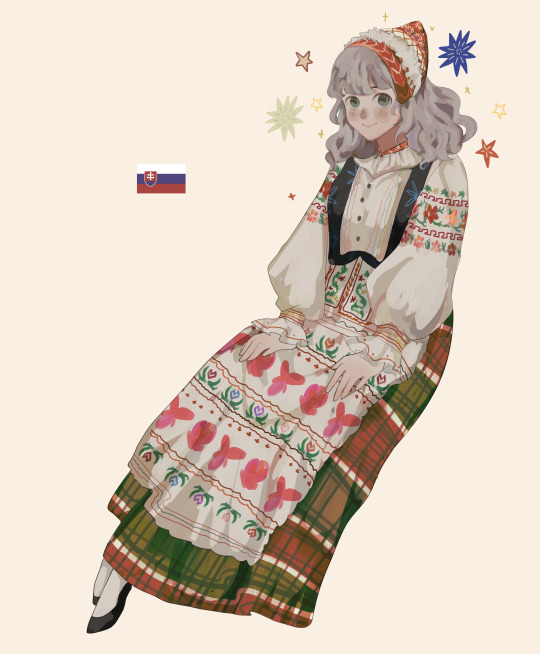

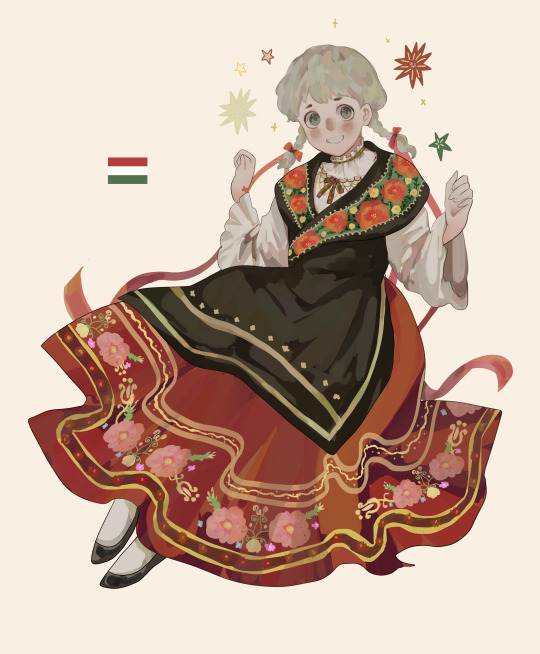
I love drawing European folk dress so much even though I am Thai ♥
#my art#polish#poland#polska#traditional clothing#folkdress#folk clothing#stroje ludowe#slovakia#slovak#hungarian#hungary#folk costume#slavic#art#digital art#artwork#Illustration#folklore#european#european culture#czech#digital painting#czechia
4K notes
·
View notes
Text

Hungarian women, Hungary, by Mohos Zsófia
451 notes
·
View notes
Text


Countess Orlok and her guards
#oc art#original character#character design#wip#vampire#nosferatu#folklore#yes I'm drawing this with symmetry guide on#because i'm lazy#countess is bit funky looking because I just wanted to sketch her dress at first#inspired by Hungarian folk clothing#digital art#i have no idea what im doing#bald lady#hehe#undead guys
4 notes
·
View notes
Text

War leaves scars in families which never truly fade away. A memorial in the Hungarian village of Vácrátót pays homage to soldiers who fought and died in WWI and WWII with a moving statue. It depicts a family of four in traditional Hungarian folk clothing, only the father figure is missing from the portrait. Instead, there is a cutout silhouette of where the soldier is supposed to be—alive, in the company of his family
Seems appropriate right now on this Memorial Day Weekend. This piece has left a lasting impression on me.
30 notes
·
View notes
Text


my laptop was dying badly while sketching (hence the messyness) these but. woe! OCEAN in hungarian folk clothing be upon ye
#ghosts art#OCEAN ai#theres a doodle of FUTURE with a kereplő + a suba too and SAYER itself in a cifraszűr but those were deemed too messy for posting#its dress is inspired by rimóci (nógrádi? i believe) népviselet
24 notes
·
View notes
Note
After I've read your Janosh post, I just have to ask this question. But since I don't know if you're the right one to ask it or not I'll do it as anon not to embarrass myself. If someone would make a Janosh cosplay, does one have to fear to be considered to practice cultural appropriation if they are not Czech/Hungarian/Slovakian? Because I would love to do a cosplay of him since I love him. But don't want to be disrespectful towards anyone.
haha no worries, it's a fair and considerate question.
i say this as a slav, but i think you should be fine. all the items/clothing featured on janosh's person are something a hungarian/magyar at that age would have on his person, and i don't think any of the items on him carry any controversial modern day symbology, only perhaps the fokos. i linked some websites to groups recreating the looks of that time period including modern recreations of those fabrics so i think you could do a fairly accurate 'cosplay'.
that being said, i urge hungarians/czechs/slovaks to weigh in as well on this topic! i personally wouldn't consider anyone trying to faithfully recreate a historically accurate depiction of a croatian folk costume/wear as anything but flattering. but looking up possible modern connotations and staying respectful of the source material is always the best way to approach it! cheers
10 notes
·
View notes
Text

Moonlight Cookie has always looked like a Hungarian folk tale princess to me.
I like the idea that her clothing constantly changes patterns as she moves just like in those cartoons.
36 notes
·
View notes
Photo
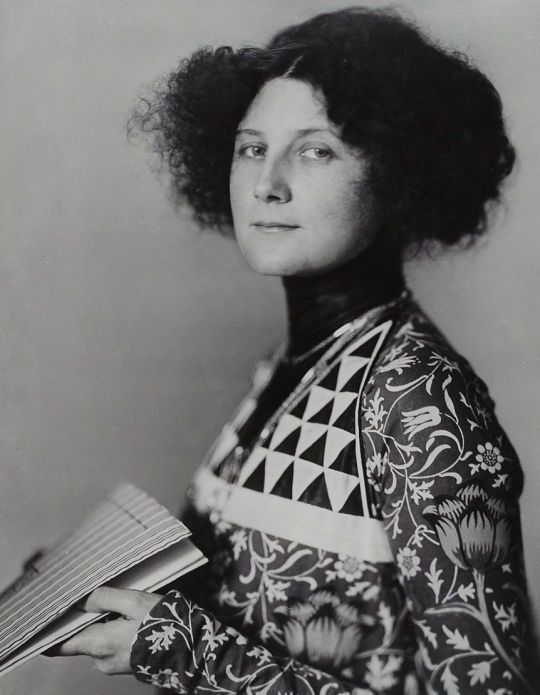
EMILIE FLÖGE (1874-1952) First liberated Viennese woman, Austrian Coco Chanel immortalized in Klimt’s phenomenal Kiss. (re)ascending the social ladder Emilie Flöge was born into a Viennese artisan family that had only recently ascended the ladder of social respectability. Her father Hermann was a master turner who had founded a firm that exported Meerschaum pipes, mostly to the British market. between silk and lace Always passionate about fashion, Emilie quickly started working as a seamstress, and when her elder sister, Pauline, opened a dressmaking school in Vienna, Emilie willingly agreed to help. Two years later, in 1895, the two of them won a prestigious dressmaking competition. In 1904 Flöge sisters opened the couture house Schwestern Flöge in Vienna, with interiors designed by Josef Hoffmann. It quickly became a successful enterprise luring wealthy clients committed to modernity in all its forms. At its prime, the company employed nearly 80 workers. reforming the dress In addition to heading the Schwestern Flöge, Emilie also maintained a direct, hands-on role in production, often pinning fabric to a dummy (custom-made to a client’s proportions) before directing fabric-cutters to reassemble it. She traveled to Paris twice a year to source fabric, belts and buttons. But what really fascinated her, was an idea to rethink women’s dress. Using her familiarity with Wiener Werkstätte projects, folk costumes and Japanese textiles, she soon created her very own Reform Dress. revolutionizing fashion stores By the time Chanel opened her first salon in Paris, Flöge had been producing cutting-edge designs in Vienna for several years. Her loose, flowing and bold dresses rejected the tight-laced style of historicist Vienna already carving out new roles for women in the industry. Flöge’s fashion celebrated physical freedom, self-expression, closeness to nature, and the vitality of other ethnicities from within the Austro-Hungarian Empire itself to the Far East. Unlike other retail stores, the Flöge sisters displayed alluring art objects that were not for sale. The store was decorated with beauticians, tortoise shell combs, marbled paper notebooks, silver chalices and hand-carved wooden dolls. Instead of copying popular design trends of the time, Schwestern Flöge was furnished with sleek, adjustable mirrors; geometric, carved wood chairs; and black-and-white chequered tables. relationship with Klimt In 1892 Emilie was introduced to Ernst Klimt, who recently got engaged with her sister - Helene. He was a talented painter gaining recognition for his work alongside his younger brother - Gustav. After Ernst’s death in December 1892, Gustav was made Helene's guardian. At that time Emilie was eighteen years old and Gustav became a frequent guest at the home of her parents, spending the summers with the Flöge family at Lake Attersee. By 1897, Emilie Flöge and Gustav Klimt had become inseparable, and most Viennese close to the couple assumed that she had in fact become his mistress. While there can be no doubt that the couple were passionately attached emotionally, and would spend countless hours in each other's company over the next two decades, some scholars have raised the possibility that their relationship always remained platonic. After 1891, Klimt portrayed her in many of his works. Experts believe that his painting The Kiss (1907–08) shows the artist and Emilie Flöge as lovers. Klimt also drew some garments for the Flöge salon in the rational dress style - a style promoted by the feminist movement - and from 1898, other clothes designed by the Vienna Secession. fin de siècle By the time Nazis invaded Austria in 1938, many of Schwestern Flöge’s clientele, who were Jewish, had fled the country or were deported to concentration camps. Like neighboring businesses — both established and burgeoning — they were forced to close. Emilie Flöge never wrote her memoirs, but despite the paucity of sources historians have been able to reconstruct the story of her powerful influence as the muse of one of fin-de-siècle Vienna's greatest artists. Among the last survivors from an utterly vanished world, she died in Vienna on May 26, 1952. KNOW MORE: https://www.harpersbazaar.com/culture/art-books-music/a12241915/klimt-muse-emilie-floge-forgotten-fashion-designer/ https://www.crfashionbook.com/culture/a22835087/emilie-floge-art-fashion-cr-muse/ https://www.encyclopedia.com/women/encyclopedias-almanacs-transcripts-and-maps/floge-emilie-1874-1952
14 notes
·
View notes
Note
Hellooo! The Kyjov folk dress you drew is lovely – much like the Polish, Slovak and Hungarian one.
If you ever decide to draw some Moravian dress again and wanna know how a certain garment or detail is supposed to look, I could help. I know a thing or two about our traditional clothing (embroidery, sewing patterns, how the older versions of the dresses looked and so on). Especially the Kyjov type :D
I actually have a whole guide on that one that I could translate to English if you were interested.
Thank you so much! I was so worried i might make some mistake drawing the dressesT_T glad the native person love it! I am so glad you willing to help me, sole info are a bit hard to find for someone outside of European hahaXD, but won’t stop me from drawing it! And of course I would love to see it, but if you have free times to translate of course! Im sure many people would love to understand folk dresses better. I want more people to draw about Czechia🥺💗
17 notes
·
View notes
Text

Hungarian woman, Hungary, by Zsofia Mohos
#hungarian#hungary#europe#eastern europe#folk clothing#traditional clothing#traditional fashion#cultural clothing
281 notes
·
View notes
Note
what sort of time period and region is your comic set in? dantes outfits are cool and I’m wondering if they’re inspired by real life cultures
Howdy! Thanks for asking!
So it’s a big ole smorgasbord
Time period is medieval. Closer to the 10th-11th century, but I’m going to be fucking around in this. For instance, in the story Christianity is just now getting introduced to Northern Europe when in reality it happened closer to the 7th century. But in the story, ppl are still following a pagan religion (which is inspired by the Celt’s deities but set up closer to a Roman pantheon) and the antagonist is backed by the Roman Catholic Church because I want there to be religious tensions as big motivators for all the major background players
But then culturally, I’ve been looking at the Celts specifically with a little bit of research into Slavic history and folklore. I’ve also been doing research on the culture in the Alps because I want the kingdom set in the topography of the Switzerland. So these are the big three cultural influences
For their clothing I think you can see my biggest influence is Slavic folk costume. I’ve been looking the most at Ukrainian and Russian clothing but I also adore Hungarian clothing and embroidery. I do plan to try and keep some Swiss and Celtic influences, but the Slavs really fucking nailed it in terms of clothing that make me want to swoon. Although I plan to make my own embroidery meanings. I’ve been researching what plants are native to the alps, and then figuring out their meanings, and then I plan to associate each character with a plant I think represents them best and make an embroidery pattern based on that for said character.
Right now though with my art I’m fucking around, so the embroidery you see doesn’t mean anything at all. But in the actual comic it’ll be more legit
Biggest piece to note though is that I do call this a fantasy story, not a historical one. These are all my influences, but my main goal is to get it to read a bit more like a fairy tale. Also I don’t want to deal with the feudal system, so I’m just not tbh
6 notes
·
View notes
Text
a little addition: renfair is a very modernized, 1960's/1970's revival influenced take on different aspects of historical clothing, mostly from the 19th century revival period and also Heavily influenced by 18th century fashions (and arguably, a lot of the basic princess dresses that are popular for kids are someone looking at a rococo gown and thinking 'how can I turn these 10 layers of fabric and intricate layering into a one piece dress after looking at this image for all of 5 seconds?')
however, a lot of the pieces that were described as being 'not a thing' in renaissance were in fact A Thing in the Kingdom of Hungary.
Hungarian fashion has remained very, very similar for about 500 years, and there are illustrations from late 1400s that depict clothing of this style. it consists of a white undershirt with full sleeves and a 'vest' on top, that is often seen with crossing lacing on the front
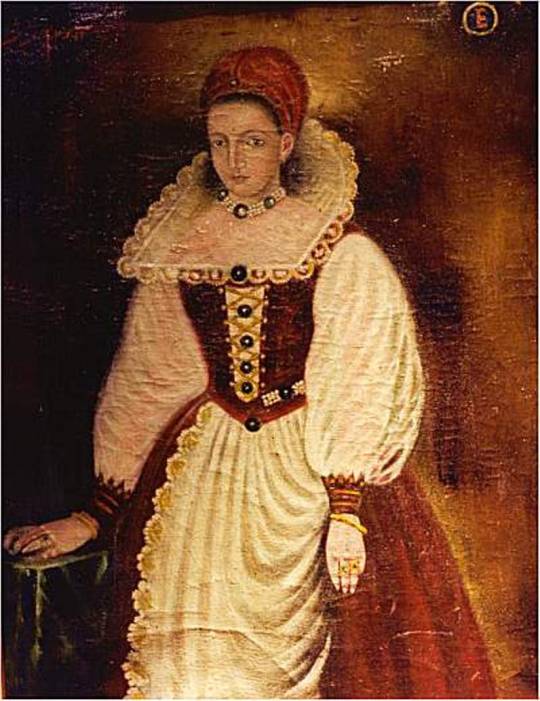
Countess Báthory for example - big sleeves, a vest that could easily be taken for stays, crossing laces in the front, and an apron (which has remained part of the court dress until the fall of the Empire! Empress Sissi wore a similar style of dress when she was crowned Hungarian Queen in the 1850s)
here are some surviving dresses, though of a slightly later date
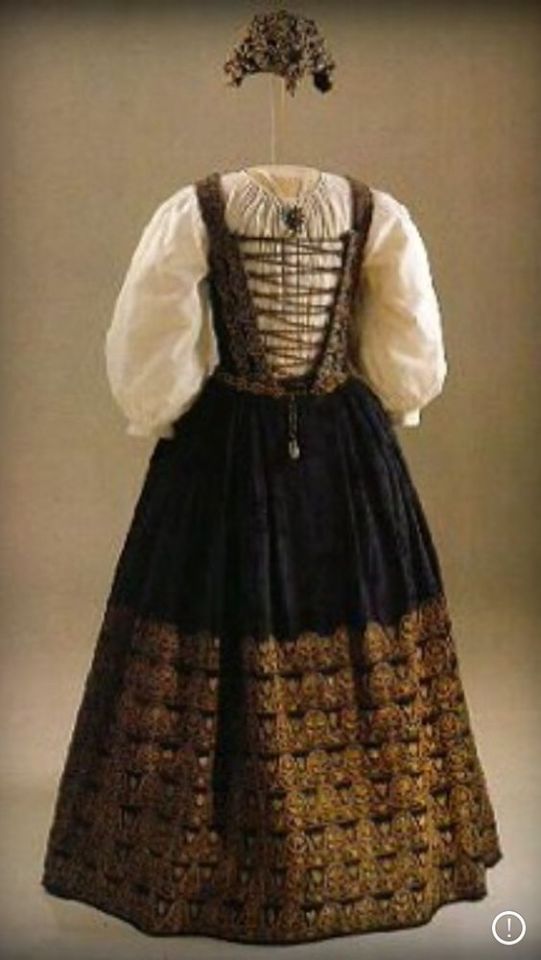


The green dress in particular is interesting because it got passed down several generations and slightly adjusted to fit the newest fashions while also incorporating more and more decoration (the most recent being the beading made out of corals)
but we can see the trends here, which have been present since before renaissance: the white undershirt with showing puffy sleeves, the boned vest that looks like stays, often cross-laced (fun fact: the ladies at court could get very creative with how they tied their laces and would try different patterns as another ways to make their dress more unique! it is also an approximate rule, at least for the renaissance gowns, that the closer the laces are to each other, the later the date. early renaissance gowns had it spaced fairly far apart.)
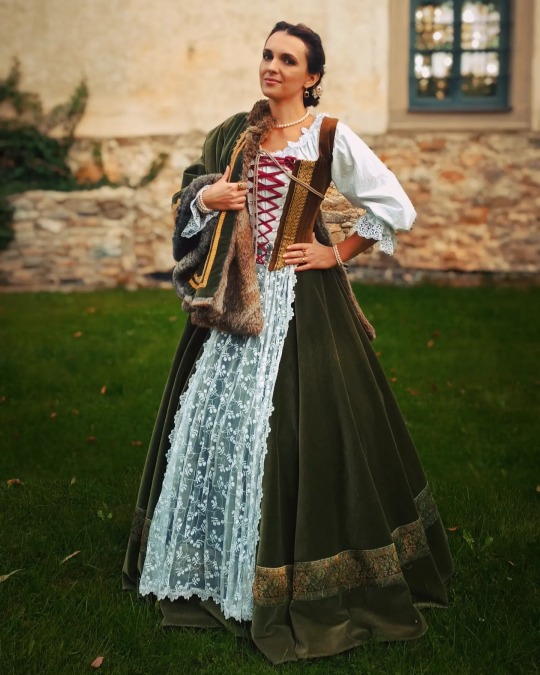


here are a few renaissance gowns, constructed in modern times by the group Fringia - they are a Slovak-based group of historians who specialize in Hungarian court dress and way of life like dance and swordplay. most of the information I provided here is from a lecture hosted by their founder and a very insightful conversation I had with her after.
their Instagram for more gorgeous pictures
you can see a lot of influences still remaining to this day in the folk clothing in countries that were once part of the Hungarian Kingdom
so yes, while the way things are still perceived incorrectly (the stays, for example) it often seems like a mix of real Hungarian fashions of the period, things being muddled by time and reimaginations and a retroactive look at what was worn by other nationalities through a western lens
it's funny although a little exasperating how artists designing "princess" or medieval-esque gowns really do not understand how those types of clothes are constructed. We're all so used to modern day garments that are like... all sewn together in one layer of cloth, nobody seems to realize all of the bits and pieces were actually attached in layers.
So like look at this mid-1400's fit:
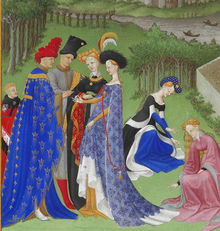

to get the effect of that orange gown, you've got
chemise next to the skin like a slip (not visible here) (sometimes you let a bit of this show at the neckline) (the point is not to sweat into your nice clothes and ruin them)
kirtle, or undergown. (your basic dress, acceptable to be seen by other people) this is the puffing bits visible at the elbow, cleavage, and slashed sleeve. It's a whole ass dress in there. Square neckline usually. In the left picture it's probably the mustard yellow layer on the standing figure.
coat, or gown. This is the orange diamond pattern part. It's also the bit of darker color visible in the V of the neckline.
surcoat, or sleeveless overgown. THIS is the yellow tapestry print. In the left picture it's the long printed blue dress on the standing figure
if you want to get really fancy you can add basically a kerchief or netting over the bare neck/shoulders. It can be tucked into the neckline or it can sit on top. That's called a partlet.
the best I can tell you is that they were technically in a mini-ice-age during this era. Still looks hot as balls though.
Coats and surcoats are really more for rich people though, normal folks will be wearing this look:
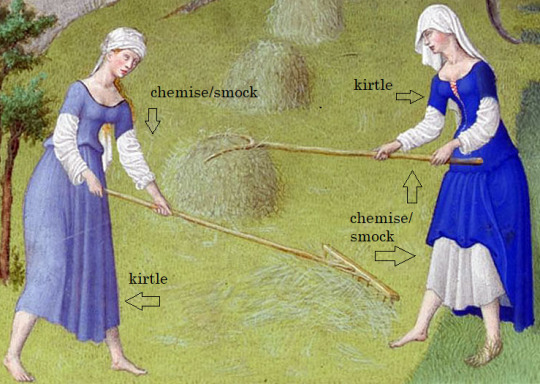
tbh I have a trapeze dress from target that looks exactly like that pale blue one. ye olden t-shirt dress.
so now look here:
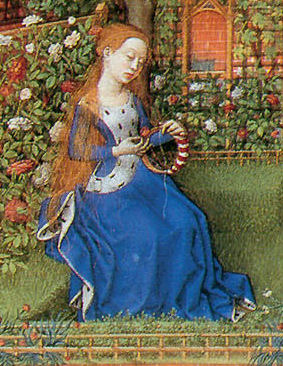
(this is a princess btw) both pieces are made of the same blue material so it looks as if it's all one dress, but it's not. The sleeves you're seeing are part of the gown/coat, and the ermine fur lined section on top is a sideless overgown/surcoat. You can tell she's rich as fuck because she's got MORE of that fur on the inside of the surcoat hem.
okay so now look at these guys.
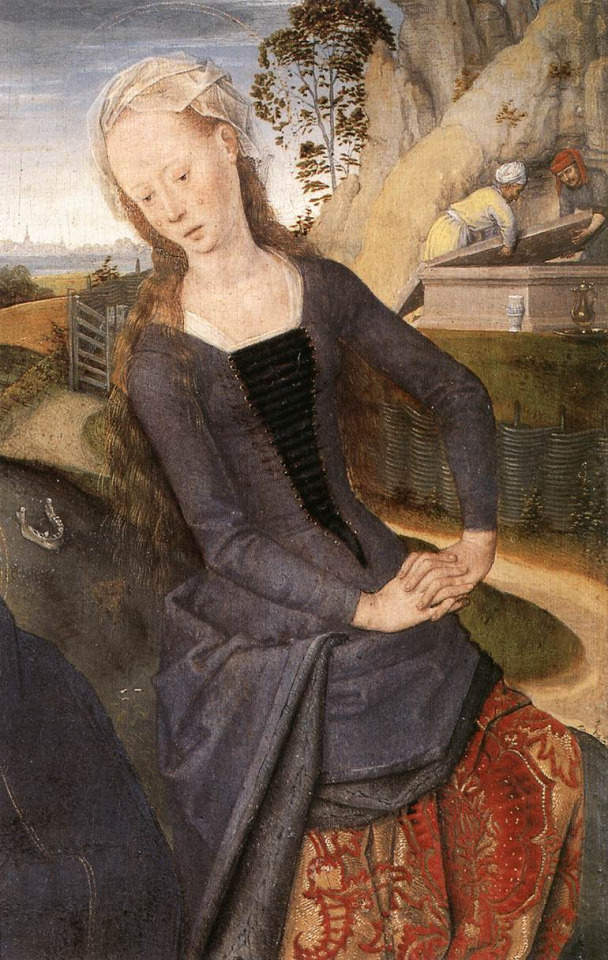
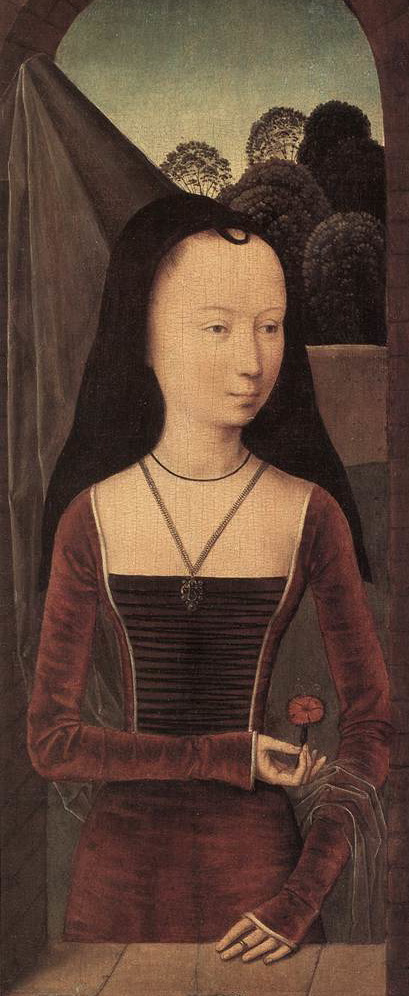
Left image (that's Mary Magdelene by the way) you can see the white bottom layer peeking out at the neckline. That's a white chemise (you know, underwear). The black cloth you see behind her chest lacing is a triangular panel pinned there to Look Cool tm. We can call that bit the stomacher. Over the white underwear is the kirtle (undergown) in red patterned velvet, and over the kirtle is a gown in black. Right image is the same basic idea--you can see the base kirtle layer with a red gown laced over it. She may or may not have a stomacher behind her lacing, but I'm guessing not.
I've kind of lost the plot now and I'm just showing you images, sorry. IN CONCLUSION:
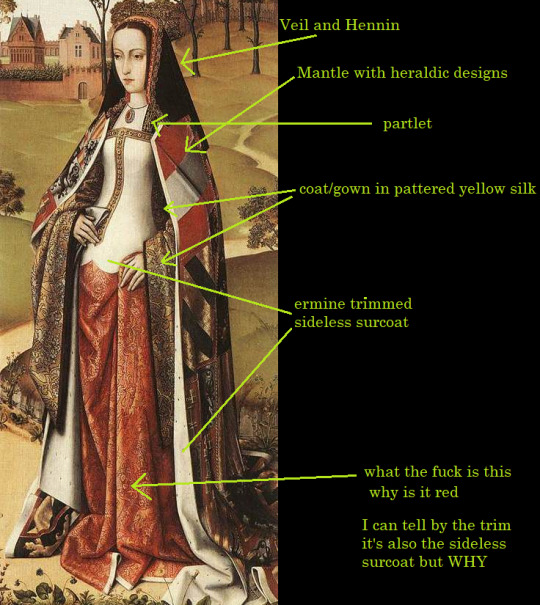
you can tell she's a queen because she's got bits I don't even know the NAMES of in this thing. Is that white bit a vest? Is she wearing a vest OVER her sideless surcoat? Girl you do not need this many layers!
#fashion history#i feel like i slightly derailed here#either way a lot of people know fuckall about hungarian fashion so I wanted to include it because its VERY different from the west#like the things that were worn here are something else entirely#i just want you to look at these because i love them so much and they are so specific!
25K notes
·
View notes
Note
https://hu.pinterest.com/otthonsziget/hungarian-folk-costumes-magyar-népviselet/
Here you go.
oooo these all look really nice! I think yeah I saw something similar when designing rayiin's outfits. I took inspo from various stuff I saw on pinterest, tbh I didn't want to give it much thought, just trying to find clothing shapes that make sense for their body while having a kind of traditional and folkloristic look
0 notes
Note
Hej, Eastern European queer appreciation ask by fellow Eastern European queer person
 Absolutely!
Honestly, seeing and talking to people who are generally considered outside of the “western spears”give me all the strength I need to talk to my fellow Americans fear about their future under the trump(especially the very very whiny one). But like then like I go on the Internet and then you just see a Hungarian trans man dancing in traditionally male folk clothing and I think to myself that things will be OK(but seriously though that guy was good;I wish I had his moves or knees). It’s going to be a tough time for all of us, but when hasn’t life, we will grow, morn the ones we will and have lost, and fight for the lives us and people in the future.
I’m still actually rather hopeful. Hell just in Thailand and just in this year so much progress has been made. Progress is still being made everywhere and will be made everywhere, always and forever. The most important thing at the end of the day is that we stick together, make sure we hold people accountable to their actions, and and support one another win and where we can.
#Eastern European queer#lgbtqplus#queer pride#transgender#it’s too early in the morning to spellcheck this so I’m not because I’m dyslexic
0 notes
Text
Summary of my session:
As I was walking in the desert I accidentally fell into a hole that had a lava pool at the bottom. No matter how much I tried I couldn't get out, the burning, horrible feeling ended my yellow life and I dragged my ex-soulmate, Bee with me.


(Red life skin, both drawn and made in Gacha)
Not long after our death, Bee along with Kazan and Soup open the portal to the end and go through to kill the dragon.
Many other follow them, but I stay out of it. I don't want to lose another life.
I can't help but worry for my soulmate, if for nothing else then our shared hearts.
By the end of the fight there are only two green lives left, Orchid and Rae. The red lives all get together for a good green hunt. The two narrowly escape my arrows and all the others weapons for a long long while until my ex-soulmate, Bee kills them.
There are no more greens left on the server.
We lost another pair this session, Catboi and Glitch. They will be missed, not by me as I've never met them, but I'm sure someone else will miss them.
This session was intense! Should probably stop reading these in public spaces, because I look very interesting if you don't know what I'm doing as I wildly gesture.
Something about the red life design of my character really shows that the clothes are inspired by hungarian folk clothing, probably because irl a lot of them use red. I decided to put the hair in braid, not only because of the fact that traditionally it's worn like that, but also for practicality.
I was listening to the Persona 5: The Animation's openings and ending on the way to uni today and I found INFINITY - Lyn to be strangely fitting for Lucky Life.
All hail the Watcher Wheel!
Lucky Life session 5
Blueishspace (He/Him) + @a-sociopath-do-your-research aka Oli (Xe/Void/It): ☠️☠️☠️
@bendy8me aka Bendy (She/Her) + @juno0n aka Juno (She/Her): 💚💚💚
@raeistrying aka Rae (She/Her) + @silverorchideon aka Orchid (He/They): 💚💚💚
@communistcatboi aka Catboi (He/They) + @theblackglitch aka Glitch (She/Her): ❤️
@kazanfamily aka Kazan (He/They) + @max05nb aka Max (They/Them): 💛💛
@twisttea aka Twisttea (She/Her) + @cowgirlginger aka Ginger (She/Her): ❤️
@italianbiscuit aka Manu (She/Her) + @lizzlylou aka Liz (They/Them): 💛💛
@thatoneloudintrovert aka Floracica (She/Her) + @not-ready-for-gaster aka Bee (She/They): 💛💛
@whats-she-gonna-post-next aka Starfall (She/They) + @frostywisp aka Fros (They/Them): 💛💛
@the-local-pineapple aka Tessa (She/Her) + @spectresharmony aka Ari (She/Her): 💛💛
@astoriagalaxy aka Astoria (All) + @3-pots-of-soup aka Soup (Any): 💚💚💚
Let's get it out the way first, the dead get to haunt the greens and yellows for one session after their death.
So first I'll spin who Oli and Blue (I) get to haunt.
Oli will haunt Astoria.
Blue will haunt Bee. (I swear when I saidI would haunt Bee so hard I didn't know it was actually happening, this is hilarious)
So, wheel time.

This is the wheel today, lots more murders and traps.
Bee, after some pushing from the voice in their head (Blue) goes into the Nether and gathers a few Eyes of Ender.
Fros begins rigging with tnt a huge patch of land around their base, 3rd Life Grian style.
Ginger threatens Liz, in response they point out the six green lives that should be eliminated first. Ginger begrudgingly agrees to the point.
Catboi and Glitch gang on and murder Astoria and Soup inside their base, just like that. 💛💛
Bendy meets up with Kazan to discuss their possession of Eyes of Ender and possibly finding the stronghold together.
Orchid burns down the birch forest...for some reason. Listen, I don't know either. Maybe he just hates birch.
Tessa steals what she can from Twistea and Ginger's base. She isn't caught.
Floracica accidentally falls into an uncovered lava pool, she dies. Bee follows soon after. ❤️ ... (Blue still haunts them because I said so)
Max also begins trapping the nether portals with lava, just in case.
Juno asks Starfall to kill her (and Bendy by proxy) so they are no longer green and stop being a target. Starfall refuses.
Ari discovers about the Ender Eye plot, she tells Twisttea who tells everyone.
Manu goes to the Nether, coming back she accidentally goes trough a trapped portal and is killed by the lava. Liz goes red with her.❤️
Rae begins trapping their base too, especially the entrance.
There are definitely 12 Eyes of Ender across the map now, the question is... will they use them?

Guess we are fighting the dragon! Oh well, you guys are fighting the dragon. I'm dead.

This is the wheel which will decide your fate.
Bee goes to the end and survives.
Floracica doesn't go and survives.
Juno and Bendy die to the dragon who yeets them far into the sky. 💛💛
Rae and Orchid hide to the side of the dragon fight and try to steal the kill. They survive.
Kazan looks an enderman in the eye and gets destroyed. ❤️
Max didn't go to the end but also dies cause of the soulbound. ❤️
Astoria falls into the void while fighting the dragon, Soup dies immediately after. ❤️
Tessa and Ari go into the end and survive the whole thing.
Manu and Liz don't go the End.
Twisttea and Ginger don't go to the End.
Catboi is killed by the dragon launching him to the ground, Glitch dies. ☠️
Starfall and Fros slay the dragon and gain the egg.
Blue and Oli observe and cheer for the whole thing while eating ghost popcorn I assume.
Well, end of the session, time for the green hunt: Now that Oli and Rae are the only greens left every red will try to get them out. So, I'll spin for every red, every time the chance of them being killed increases until they die and go to yellow. This isn't really a "will they survive? It's more "how kong will they last?"
Max doesn't kill them, was hoping for the betrayal but nada.
Bee isn't able to kill them.
They barely escape Floracica.
Twisttea and Ginger fail to kill them.
Manu and Liz also fail to kill them.
They escape from Soup and Astoria.
Kazan comes close but they still live.
... They are still alive... The reds come together to kill them... I'll just tell you how many wheel spins it takes to kill them.
Orchid first and Rae immediately after are killed by Bee. (And the other reds, Bee is the one in Orchid's death message) After 9...9 additional wheel spins for a total of 16 spins. Scott would be so proud. 💛💛
The session, finally ends.
64 notes
·
View notes
Text
It has been ages since the time of difference and beyond for the age of harmony. It seems we are at peace, for now. No longer fenced in by stately aggressors, we are finding peace. They may have called the last century 'Pax Americana', it was far from Pax-ful for most of us.
Euterra has been good to us. Most of us are matriots, now. There are clashes still, but it feels like we have grown past that, like clashing was childish or something.
It feels like Earth has grown up. I get it now; I understand why the Others kept us locked.. up... here.. like that. Wow.. ever since their arrival, I have always said "locked up," but now that I.. after what they showed us... it feels wrong to use. "Locked up"?
Anyway, since then, a lot has changed. But also, not that much. Their arrival was a jaw-dropper, for sure, but it was also a Tuesday, and the students had a mid-term, payroll was due, and Steven wouldn't hurry up, and so we were late.
I like the new provinces. I also love the clothing! (As much as I want, perfectly tailored to my size, for free?! All the time?!) Sure, it is a little floraly (it comes with territory; we Hungarians love our floral designs), and boy is it heavy, but it sure is gorgeous! And my boots? I adore them! (Though, an easier time taking them off would be nice. It's okay, though, this is why I have Steven)
Ah, Steven is perfect (except when he is not)(like that morning)... I never expected to fall in love with an Englishman.. their teeth, their bark. But, I have grown up a lot since then, especially since I met him, and he has opened my eyes to a.. whole new woooorld
I always found it funny how English folk need to prune themselves. Imagine only cutting your hair once or twice a year?! If I did that, my tail would probably sweep the ground. Plus, his teeth really aren't that bad; I guess I am just used to Anglo-Canadians getting braces for their tusks, but how can I say anything when I can barely stand cleaning my hooves out because of how gross they are
0 notes